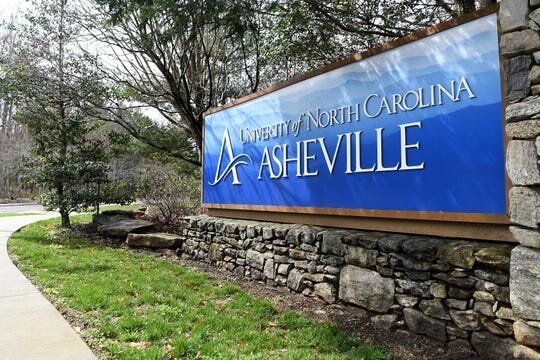This page is licensed under Creative Commons under Attribution 4.0 International. Anyone can share content from this page, with attribution and link to College MatchPoint requested.
Get in touch
Posts tagged College Spotlight
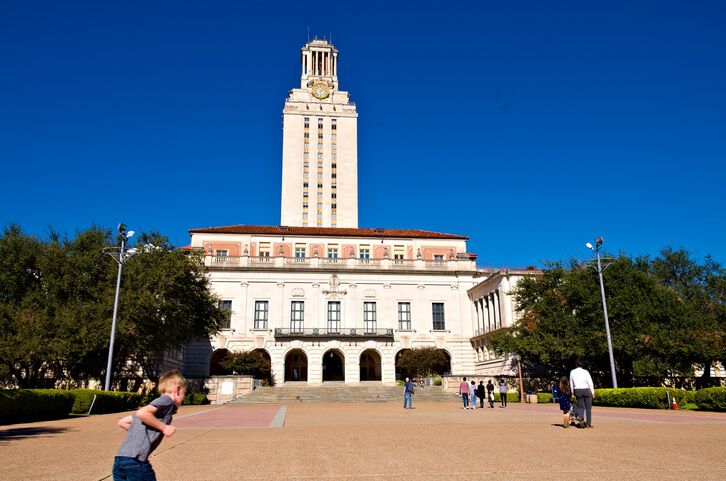
By Bob Carlton
•
12 Jan, 2023
If your student bleeds burnt orange, it’s never too early to start thinking ahead academically and strategizing course selections. The ideal course load not only fulfills graduation requirements but also should reflect the intersection of your student’s academic abilities and enjoyment of the subject matter.
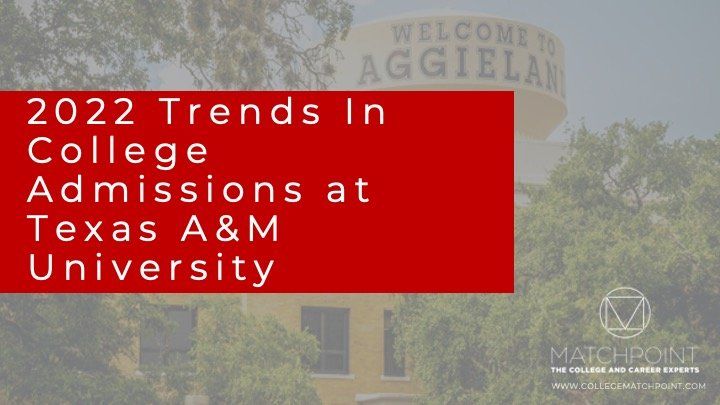
By Bob Carlton
•
01 Aug, 2022
Over the last 15 years, our team has worked with thousands of students who applied to The University of Texas at Austin. Our team is excited to share with you our analysis of the trends in admissions to UT Austin, as well as the implications for students who hope to #BeALonghorn.
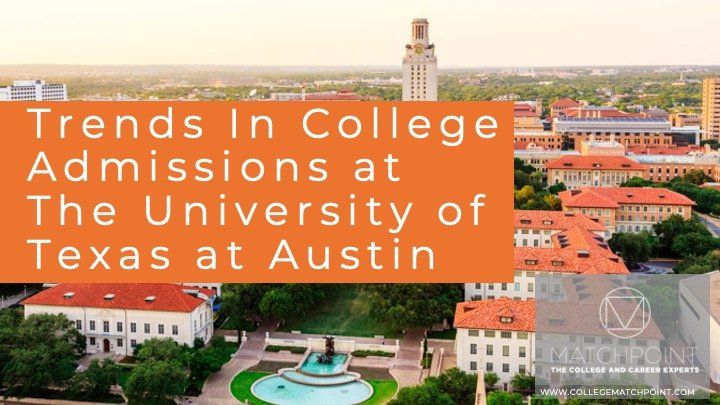
By Bob Carlton
•
25 Jul, 2022
Over the last 15 years, our team has worked with thousands of students who applied to The University of Texas at Austin. Our team is excited to share with you our analysis of the trends in admissions to UT Austin, as well as the implications for students who hope to #BeALonghorn.
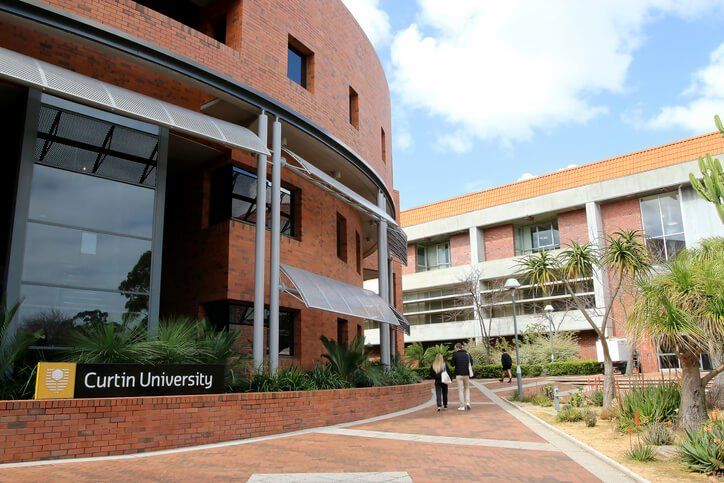
By Josh Neimark
•
05 Nov, 2021
Students at Bentley University work and live on a traditional-feeling college campus, located just 9 miles from Boston in the suburb of Waltham, MA. Known for a unique focus on both business and the liberal arts, the school is worth a look for potential business students who also want to explore other academic interests. Recognized by the Sierra Club as one of the nation's greenest campuses, the EPA also singled out the school for being a top purchaser of green power. Sustainability is at the heart of everything at Bentley, which created a strategic plan to reach carbon neutrality in 2010. Freshman are housed in one of three dorms, with apartments, suites and houses available for upperclassman; a full 80% of the total student body live on some sort of campus-managed housing. Bentley offers both co-ed and single sex floors, as well as gender-inclusive suites. Additional themed live/work options (called Defined Communities) exist in the areas of Social Justice, Arts, Wellness, Women's Leadership and Service Learning, to name a few. Dining options on campus are deemed average, but the suburban location and proximity to Boston offer plenty of alternatives. While business is the main draw at Bentley, a full 50% of the curriculum is arts- and sciences-related. The first two years for all students requires a focus on general business courses as well as arts & science electives. Liberal Studies and Business Studies are two secondary majors offered to those students who wish to pursue double majors. With a 12-1 student to faculty ratio, students have great access to professors; Bentley students are also paired with mentors in their chosen fields of study. Internships are popular, with more than 60% of students completing at least two before graduation. And with 94% freshman retention and graduation rates, students seem very happy with life and studies at Bentley. Fast Facts: 46% acceptance rate 4,689 full-time students Average SAT 1240; Average ACT 28 Similar schools include: Babson, Bryant, BU and BC No class has more than 36 students 14% Greek, 60% male, 40% female Ranked among "Top 10 Undergraduate Business Schools" in 2016 by Bloomberg BusinessWeek Total tuition, room & board and fees: $63,000 Applications are all read 3 times; top 10% of admitted students invited to Honors program Fun Facts: 50 study abroad programs in 26 countries (nearly half of all students participate) NCAA D2 Women's Basketball Champs The Big 4 accounting firms have close ties to Bentley and grads are top picks Average first-year salary for grads: $53,000 Notable alums include: Sprint President and CEO Marcelo Claure, Former Maine Governor and US Senator Frederick G. Payne, and Dallas Cowboy Mackenzy Bernadeau Give us a call if you are interested in learning more about Bentley University.

By Josh Neimark
•
23 Mar, 2020
Catholic is in the name, and it is officially The National University of the Catholic Church, but that doesn’t mean you have to be Catholic to attend The Catholic University of America (CUA) . While 80% of students are Catholic, Rebecca Allen, senior associate dean of admissions, assured our visiting group of college counselors that all faiths and religions are welcome. My tour guide, a student from Los Angeles who did happen to be Catholic, said that she had two professors who were Jewish and one who was Islamic and she felt that the university culture was very open to all religious perspectives. Students do have to take 2 or 3 religion classes, depending on their major and a wide variety of choices are available. When describing why she chose Catholic, our tour guide said it originally wasn’t high on her list. Then she went to visit and was blown away by how close the community was and how much she felt like she would be valued on the campus. “That wasn’t at all how I felt when visiting some of the state schools in California,” she said. Small University, Large Campus As the largest self-contained campus in Washington, D.C., CUA might warrant a spot on your college list if you want a small school (3300 undergraduates) in a major city with a comprehensive advising (including integrated academic and career advising) program. Every student has a dedicated four-year professional advisor and a major advisor. At CUA you’ll be part of a strong campus community as well as a global research university with a 7:1 faculty-student ratio. The school is right on the Metro with easy access to all areas of the city and the airport. All students take a “Washington 101” class as part of the Freshman Experience to master the Metro, learn about the best food trucks, and how to take advantage of all the free museums in D.C. TEST-OPTIONAL FOR ALL PROGRAMS One unique aspect of CUA is that it is test-optional for all of its programs, even for Honors, Engineering and Nursing. “Our emphasis is on four years in a classroom vs. four hours on a Saturday morning,” Allen says. NEW AND NOTABLE PROGRAMS Are you interested in both music and business? CUA has a new dual degree in Business Management and Music . The Busch School of Business offers 15 d ifferent speci alizations including Entrepreneurship, Sports Management, and Business and Public Policy. The School of Architecture and Planning offers an uncommon 5-ye ar dual degree pro gram in architecture and civil engineering . Students are identified as a potential candidate after their freshman year. CUA offers the premier school of social work in the U.S ., including a 5-year master’s program. Nursing is the most competitive major and the only major in which you have to apply directly. A recent $20 million donation to build a new nursing building means that the 90 spots currently available for nursing majors will double by 2022. National Institute of Health affiliations mean that Biology and Biochemistry students work on cutting-edge research . A 3+3 BA/JD pro gram with CUA’s Colu mbus School of Law allows students to apply after their freshman year. MERIT SCHOLARSHIPS Merit scholarships are offered from $10,000 to $25,000. Legacy students receive $1,000 annually automatically. Members of a Catholic parish can receive $4,000 per year. Archdiocesan Scholarships offer full tuition. For consideration, students must be at the top of their high school class with at least a 3.8 unweighted GPA in a highly demanding curriculum. Finalists must participate in an interview with university faculty. No separate application is required.
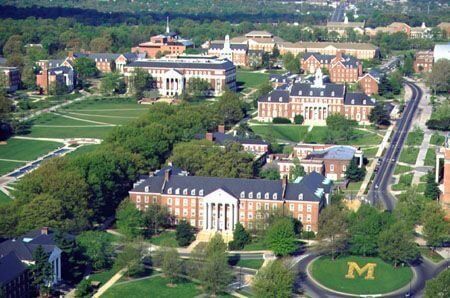
By Josh Neimark
•
23 Mar, 2020
According to my sophomore tour guide, most University of Maryland (UMD) students are those who were “very involved” in their high schools. During our tour, she rattled off a long list of her activities and leadership from her Maryland high school and it made our group of counselors’ heads spin. In college, she is pre-med and again involved in many different activities and groups, including Greek life. One of her favorite aspects of University of Maryland is the diversity of the student body , and the percentage of out of state students (about 27%), which she said added to her experience. If you’re looking for a traditional big university with a beautiful campus, Greek life, and great sports teams, (including standout men’s lacrosse and football programs), you might want to consider adding UMD to your list. UMD’s proximity to D.C. is a draw for many students. In 2022, a new light rail system will open right on campus to connect students to the Metrorail Red, Green and Orange lines as well as to Amtrak, busses, and MARC commuter trains. Right now you have to take a shuttle to the Metro. This new Purple Line will save students time in getting to D.C. for internships or weekend visits as well as to other Amtrak destinations. MAKING BIG FEEL SMALL New, learner-friendly buildings such as the Teaching & Learning Transformation Center (TLTC) make large classes feel smaller. For example, lecture style classrooms in the building feature seats that turn all the way around so all students can interact with one another in class. And several bigger classrooms in the TLTC have circular tables to facilitate group learning. Classes from all different majors meet there. UNIQUE TRADITIONS On campus, students present offerings to Testudo, the bronze sculpture of a diamondback turtle that sits overlooking the Mall in front of Mckeldin Library, to give them good luck. These aren’t just your average offerings. On our visit, Testudo had been offered a doorknob, and part of a desk. FOCUS ON INNOVATION AND ENTREPRENEURSHIP UMD stands out in its commitment to fostering entrepreneurship and creative thinking through several unique initiatives: UMD’s Academy for Innovation and Entrepreneurship (I&E) has a mission to engage all students in I&E during their educational experience. The Dingman Center for Entrepreneurship offers the largest university-run angel investor network. Any student can pursue a minor in innovation and entrepreneurship . UMD started the nation’s first living-learning entrepreneurship program . In Hinman CEOs, entrepreneurial students from all technical and non-technical academic disciplines live together and learn about entrepreneurship and ethical leadership. They can also launch new ventures. Any undergraduate can apply for this competitive program. MOST POPULAR MAJORS Just as with most large universities, some majors are harder to get into than others. Here’s a list of UMD’s Limited Enrollment Programs: Biochemistry Biological Sciences Business Chemistry Communication Computer Science Criminology and Criminal Justice Engineering (UMD offers typical engineering majors plus a program in Fire Protection Engineering , as well as minors in niche fields such as nuclear engineering ) Environmental Science and Policy (ENSP): Biodiversity and Conservation Biology Government and Politics Journalism Neuroscience Psychology INDIVIDUALIZED ACADEMIC PATHS For highly independent students who want to pave their own way, Maryland offers an Individual Studies Program https://www.ivsp.umd.edu/overview-ivsp.html where you can create your own major. If you’re an exceptional student, you can also create your own combined BA/MA program . Merit Scholarships For out of state students, UMD offers merit scholarships from 2,000 to full tuition.
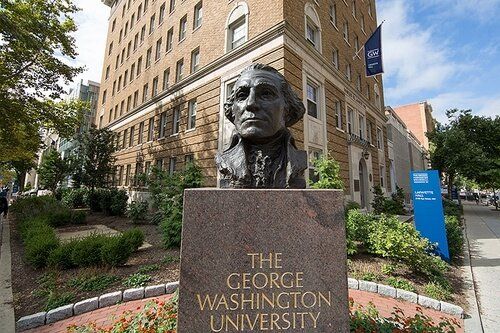
By Josh Neimark
•
07 Mar, 2020
If you think you want to go to a medium-sized college in the middle of a city, you might want George Washington University (GWU) on your list. The Foggy Bottom Metro stop, which is right in the center of campus, is your quick link to anywhere in D.C. But what you might not know is that there is also another, smaller campus - the Mt. Vernon Campus - which is a quick shuttle ride away from the main campus. It has a smaller, liberal arts feel with a lot of green space that appeals to many GWU students, some of whom choose to live in dorms there. Some smaller classes are held there and that’s also where the athletic fields are. My tour guide, Tina, is a junior from China studying international affairs and social and cultural anthropology. She was upbeat about her experience at GWU. She said the hardest part of the adjustment was getting used to peculiarities in the language. For example, after moving into her dorm (by herself, since her parents didn’t travel with her) she went to a local restaurant and was mystified by why her beefsteak tomato burger had no beef in it. Turns out it was a vegetarian restaurant and beefsteak is a type of tomato. Since there’s no cafeteria at GWU, students have a debit-like card for meals that they buy from 120 local restaurants and from the Whole Foods in the middle of campus. And yes, rest assured there’s a Chick-Fil-A in the campus food court. While some might find it strange that there’s not a centralized cafeteria, students have plenty of options to choose from and seem to delight in their choices and their ability to “eat out” for every meal. What stood out most to me at GWU were the unique and innovative programs and facilities offered, including: A new study abroad option in Antarctica spearheaded by a professor A global BA degree where you spend three semesters abroad Amazing research opportunities since it is a Tier 1 research institution. Professors invite first and second-year students to research with them, and students are encouraged to pursue their own research. The ability to help staff the annual World Bank conference held at GWU A Knowledge in Action fund that covers costs for students’ unpaid internships Community Service opportunities at orientation and during spring break Fixed tuition for five years A 7-year BA/MD fast-track program A 4-year honors program for students who are “intellectual audtitors” who love applying what they’re learning and finding intersectional points of their classes Lisner Auditorium, the second biggest performing arts space in D.C. behind The Kennedy Center (lots of speakers come to campus and students enter a lottery to get tickets. Recent examples include a presidential debate between Ted Cruz and Bernie Sanders) The impressive new science and engineering building Tina mentioned that her freshman classes were large, and she struggled with a 200-person world history class in her first semester. When she went to her professor’s office hours, she broke down in tears. Her professor reassured her and remembered her name, often checking in with her when he saw her to ask how she was doing. “I guess crying is a good way to make your professors remember your name,” she said, laughing. Her classes now are more in the 20-40 range and she said GWU students typically take 5 classes per semester. She thought she was going to minor in art, and talked about a drawing class she took where the professor brought 🐶 his dog to class. It delighted everyone except for her because she’s scared of dogs. Ultimately she decided there weren’t enough art classes she was interested in so she switched her minor to anthropology. She raved about her mandatory university writing class called Feminist Filmmakers. Other fun facts about GWU: most of the campus is in a no-fly zone because of its proximity to the White House and the chemical engineering department is located on the Mt. Vernon Campus for the same reason. A statue of a hippo named Martha resides outside Lisner Auditorium and students rub her nose and sacrifice burritos in her mouth for good luck on exams.
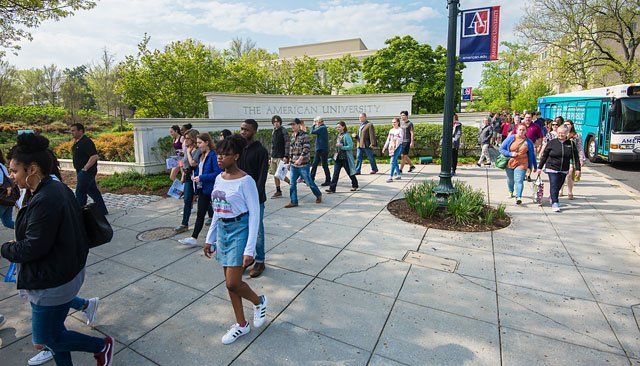
By Josh Neimark
•
07 Mar, 2020
Even though most students at American University (AU) were away on spring break when I visited and no tours were offered, Zach, a friendly junior from Connecticut, graciously offered to escort me around campus after the information session before heading to his job at the campus swimming pool. Zach had known he wanted to be an FBI interrogator and/or profiler since he was in middle school and got hooked on TV crime shows. He raved about his recent law enforcement internship and about how much he loved his experience at American, especially the engaged and active student body. Walking through the main green on campus, I definitely felt like on was on a traditional campus with a scholarly feel. The academic buildings surrounding the green practically oozed knowledge. It was a beautiful, warm day and if students were on campus, Zach said they would be out on the green enjoying themselves or getting work done outside. Career Focus I walked through many of the academic buildings, which were all open. I especially liked AU’s Kogod School of Business, which boasts its own Office of Career Engagement (separate from the main career center for all other students). When I stopped in, one of the directors told me about the office’s many “treks” they take students on to explore career fields. For example, there was a finance trek to New York City where students visited financial firms and networked with people in the industry. There was also a Business in Entertainment trek to California, among others. Kogod’s Office of Career Engagement utilizes students’ ideas to help them bring more students in to their office for career guidance. The woman I spoke with pointed to their “March Madness” events as an example. A student with graphic design skills had come up with a compelling flyer to advertise the March career events. Another interesting fact about Kogod’s Office of Career Engagement is that they bring in therapy dogs for students to practice their presentations to help get rid of public speaking jitters. Also, Kogod offers an entrepreneurship incubator that pairs students with experienced mentors, grants, networking, workspace, and educational opportunities and it is open to any student, not just business majors. Location, Location, Location One of the benefits of American is obviously its Washington, D.C. location. It’s not right downtown, however. Rather, it’s nestled in the beautiful residential area northwest of the city. A free shuttle transports students to the Tenleytown-AU Metro station (on the Red Line), which is otherwise a 21 minute walk. I decided to test it out to see how long the process took. I waited 16 minutes for the shuttle, which took about 10 minutes to get to the Metro station. Once there, the train came quickly and it was a short ride to Metro Center where you can transfer to other Metro lines. American students get an unlimited U-Pass for free rides on both the Metrobus and Metrorail, so internships in downtown D.C. are easy and affordable to access. Commitment to Learning American is known as being a learning-friendly university with its small, seminar-style classes and robust Academic Support and Access Center. You can switch majors easily and the core curriculum is flexible and cross disciplinary. It also has a test-optional application, which is helpful for students who don’t shine on standardized testing. Students who struggle with foreign languages will be happy to know that there is no foreign language requirement for students, unless it’s required for a major such as International Studies (AU’s most popular major) or Business Communication. And if you’re in a hurry to get out into the working world, there are three different three-year programs, including Public Health Scholars Program, the Politics, Policy and Law Scholars Program , and the Global Scholars Program .

By Josh Neimark
•
13 Jan, 2020
Independent studies, or capstone projects, can be a fantastic way to delve further into an academic area of interest, by completing a long-term, multi-faceted project. Students can complete these projects over the summer or integrate them into a junior- or senior-year course load. Whether it's developing an app, writing a play, or designing a robot, these projects allow students to pursue an area of personal interest in greater depth than the standard curriculum allows. And for students hoping to attend a highly selective college, digging deeper into an established interest is a great way to show schools that they're a motivated self-starter. As your student considers whether an independent project is right for them, here's what they should be thinking about. CHOOSING AN AREA OF FOCUS In order to pursue an independent project, your student needs to have an area of focus that's meaningful for them. Whether it's a new topic or an extension of a project they did for another class, the project will only be successful if they're excited about it. As they review possibilities, students should consider these key questions: How much initiative does this project require? Do I have the resources available to complete this project? Am I taking a risk or challenging myself in this project? What is the impact of this project, both for myself and for others? They should feel comfortable with and encouraged by the answers to these questions if they choose to move forward with the project. COORDINATING WITH THE SCHOOL Before getting started, it's important that students check in with their schools about how to best implement their project. For example, there might be an existing effort at the school that's of interest to the student; coordinating their independent project with the school's existing program will make the process easier for the student and more impactful for their community. Even if such an effort doesn't exist, the school may be able to recommend a teacher or other mentor who has expertise in the focus of the student's proposed project. Many schools also offer independent study credit, which school counselors can typically help define. These projects may require an extended application process, so students will want to be sure they're checking in and following it closely to gain approval. EXECUTING THE PROJECT If your student decides that an independent study project is right for them, here are three tips for making the most of it: 1. Start with a plan. Students should make a plan for how much time they'll spend on the project to be sure they're putting enough effort into it but not letting it get in the way of other work. Once they begin work on the project, students should keep track of how many hours per week they spend to be sure it lines up with their expectations. Going in without a plan can cause students to overwork and/or not reach their goals. 2. Find a mentor or advisor. Because they're reaching beyond the standard curriculum, a student will have to go out of their way to find a teacher or advisor to help them with an independent project. This is especially important if they want the project to count for credit, but it's helpful either way to have an experienced guide throughout the process. If there are no teachers at their school who are willing or able to assist, a student can reach out to a college professor or graduate student to assist with college-level research. 3. Focus on tangible outcomes. To be able to demonstrate that the time spent on this project will be meaningful, students should determine what the output or accomplishment of the project should be. Setting a goal will ensure that the project is feasible and impactful and will, of course, keep the student on task. For example, creative projects can be submitted for contests or publication. Or, if a student creates an app or an online video, a goal number for usage, followers, or revenue can help the student stay on track—and impress college admissions officers. For many students, independent study projects become one of the most satisfying components of their high school academic career. Students we have worked with have completed projects ranging from works of art to research papers to software development projects. These projects require extra time and effort, but the results can be invaluable for the student and compelling for highly selective colleges.

"College MatchPoint helps steer and advise you from beginning to end of the college search and application process. They take what can be a very stressful time and break it down into smaller, manageable pieces. Bob, Lisa and their staff support their student clients, enabling them to find the best fit. You can trust that the process will work; it did for all 3 of my very different kids."
— Ellen Miura
Subscribe
Sign up with your email address to receive news and updates.
Email signup
Thank you for contacting us.
We will get back to you as soon as possible.
We will get back to you as soon as possible.
Oops, there was an error sending your message.
Please try again later.
Please try again later.
© 2024
ALL RIGHTS RESERVED | COLLEGE MATCHPOINT | SITE BY FIX8


